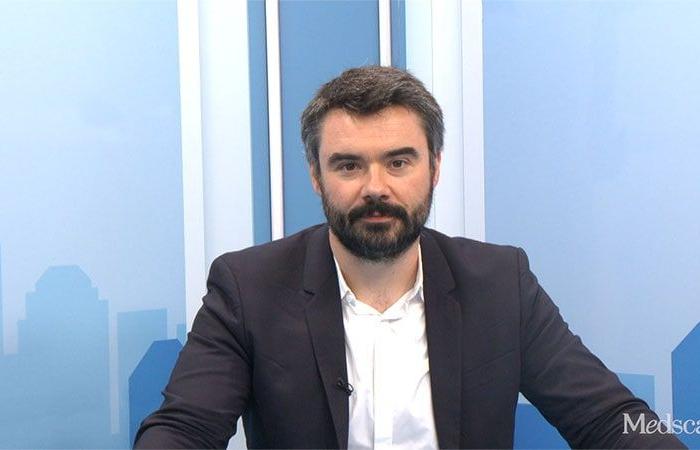While the PODIUM trial shows an improvement in survival in patients with anal canal cancer, the TOPGEAR and PANDAS studies raise the question of the place of radio-chemotherapy in resectable stomach and pancreatic cancers. The point with the Dr. Aurélien Lambert
TRANSCRIPTION
Hello, I am delighted to be back with you on the Medscape set, live from ESMO 2024 in Barcelona. I am Dr. Aurélien Lambert, a medical oncologist at the Institut de cancérologie de Lorraine in Nancy, and I am going to talk to you about gastrointestinal (GI) cancers, and more specifically about three studies that caught my attention.
PODIUM: Improved survival in patients with anal canal cancer
One of these studies was presented in plenary session, and for me it is the highest on the podium; it is precisely called POD1UM-303/InterAACT 2 . [1] This is something quite rare for the GI and even rarer for the anal canal.
This is quite an interesting study, since we had a population of patients with anal canal cancer that was either locally advanced, metastatic, or recurrent, so with only non-curative strategies, and with chemotherapy that is not quite the standard everywhere. In any case, it is an option, of course, but it is not always preferred by the centers.
It was tested: a combination of retifanlimab (anti-PD-1 immunotherapy) with carboplatin-paclitaxel, so a classic chemotherapy combination. What was very interesting is that the patients were randomized 1 to 1 in an arm carrying the immunotherapy and an arm with placebo, so it is a “pure” study.
This beautiful study, in my opinion, is enough in itself to change the standards.
The question was clear, and above all, the answer was excellent, since the study is positive on its main evaluation criteria, and in particular survival. So we have an improvement in survival in patients with anal canal cancer (squamous cell carcinoma). And this beautiful study, in my opinion, is enough in itself to change the standards. In any case, this is the conclusion of the team that presented it. English team, but, we must also say “cocorico” because we have many centers that participated in this study, so there is also a very French representation.
In conclusion: a positive study, presented in plenary, probably a new standard, and that is a beautiful thing.
TOPGEAR: preoperative chemo-radiotherapy in resectable gastric cancer
The second study that caught my interest was TOPGEAR . [2] It is a little different and perhaps a little disappointing, it must be admitted. In adenocarcinomas of the stomach and the gastro-oesophageal junction, it was a question of testing a combination of perioperative chemotherapy with or without radiochemotherapy.
This study is well constructed, raises a good question – we could discuss the choice of chemotherapy which was ECF (epirubicin + cisplatin + 5-FU) in a good part of the files, but it is also historically due to the fact that the study is a little old and the FLOT standard (5 Fluoro-uracil Oxaliplatin Docetaxel) had not necessarily been disseminated in all centers. So the association of perioperative chemotherapy and radiochemotherapy, unfortunately, does not do any better. There is no signal interesting enough in this study to conclude on a benefit from the addition of radiochemotherapy. So it is a study that is both disappointing, but which teaches us something, since the place of radiotherapy is always interesting to discuss. Knowing that it should not be done is, in my opinion, something quite useful, since we could be tempted to propose it to selected patients. In any case, I think that the discussion can always be postponed, but as a standard we remain on the classic perioperative and therefore today, the FLOT.
In conclusion: a good study, unfortunately negative since we would have liked the choice to be the right one.
PANDAS-PRODIGE: what place for the Radiochemotherapy in resectable pancreatic adenocarcinoma?
Regarding the third study, I am somewhat judge and jury since I presented it at the first session of Proffered Papers, This is the study PANDAS-PRODIGE 44 . [3 ]We are interested in patients who have resectable pancreatic adenocarcinoma. borderlinethus a niche among potentially operable patients.
This study was highly anticipated because once again we are asking ourselves the question of the place of radiochemotherapy. And there, we had decided to do neoadjuvant chemotherapy with Folfirinox 6 cycles, randomization with radiochemotherapy versus nothing, that is to say surgery immediately after the chemo. The patients were operated on and in both arms they had, of course, the continuation of chemotherapy with six additional cycles in adjuvant to bring the total of courses to twelve courses. The trial was judged on a primary criterion which was the R0 resection rate.
This R0 resection rate was achieved in 50% of cases in the chemotherapy alone arm and in 45% of cases in the combination arm. Unfortunately, there is therefore no significant difference between the two arms, no a priori benefit of concomitant radiochemotherapy in the sequence.
We could leave it there, but I believe that there are some fairly strong messages that come from this study. First, the fact that radiochemotherapy, once again, has no place in pancreatic cancers, this time borderline resectable. But perhaps in a more practical way for the clinic, we realized that neoadjuvant chemotherapy was extremely well tolerated – 95% of people had the six cycles of neoadjuvant chemotherapy. It is modified Folfirinox, of course, but a Folfirinox nonetheless. So this is a message that we do not always have in the trials, neoadjuvant chemotherapy goes well and above all the adjuvant was, in the cases where we were able to do the adjuvant treatment of the operated patients, carried out in more than two thirds of the cases in a complete manner.
So chemo is easy to do and it works well, since in the end, yes, it was a secondary endpoint, but the overall survival of people in both arms was quite good, more than 30 months, and we had 32.8 months, almost 33 months in the chemo alone arm and exactly 30 months in the arm of the combination with radiotherapy. These are data that are rather favorable compared to what we read in the literature.
So, today, the message is that for patients, no radiotherapy a priori, but above all, do these sequences. It is now a standard of the ESMO, recognized in the guidelinesit must be done and without fear in my opinion, since the management of Folfirinox is now excellent. It is a multicenter study which shows that everyone has taken to this treatment well and patients seem to benefit from it.
So there will not be a phase 3 strictly speaking in this same indication, because of the results. On the other hand, this chemo will probably be studied a little, and then we expect that it will be in the PANDAS study of course, and in the trials that I mentioned before, the “transla” analyses, since the translational studies will probably show us that there are subgroups of patients with molecular particularities that are of interest. I think that we will perhaps be able to find signals of interest on radiotherapy in certain patients, it is not excluded, but above all what we really lack in this pathology, in any case for the pancreas, is to have a fairly practical dismemberment so that in care, in routine, we can also know which patients are most likely to benefit from this or that sequence. Genomic signatures have started to answer the question, but it is not enough. We need to go a step further and give practitioners the keys to find the right treatments. Perhaps neoadjuvant chemotherapy should be chosen based on these sequences.
So that’s it for the little one. heads-up of this ESMO concerning non-colorectal. In any case, these are trials that are not all positive, certainly, but which all provide a real clinical answer to field questions that we ask ourselves. Thank you for following this little capsule for my greatest pleasure. See you soon.






